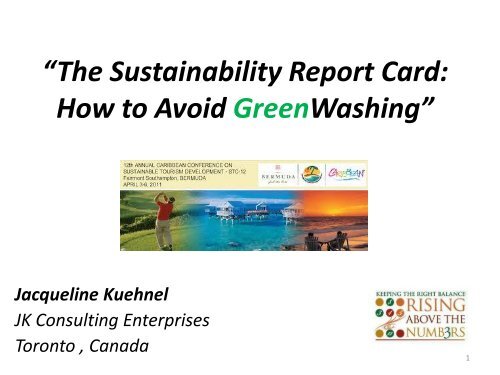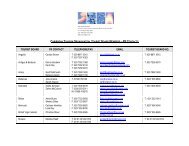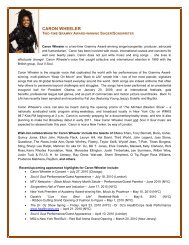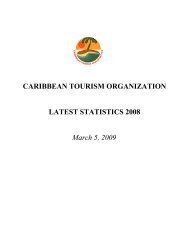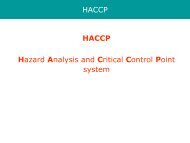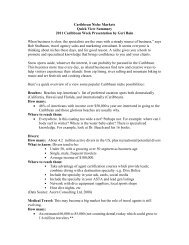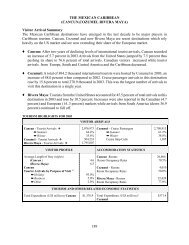âThe Sustainability Report Card: How to Avoid GreenWashingâ
âThe Sustainability Report Card: How to Avoid GreenWashingâ
âThe Sustainability Report Card: How to Avoid GreenWashingâ
Create successful ePaper yourself
Turn your PDF publications into a flip-book with our unique Google optimized e-Paper software.
“The <strong>Sustainability</strong> <strong>Report</strong> <strong>Card</strong>:<br />
<strong>How</strong> <strong>to</strong> <strong>Avoid</strong> GreenWashing”<br />
Jacqueline Kuehnel<br />
JK Consulting Enterprises<br />
Toron<strong>to</strong> , Canada<br />
1
Key objectives<br />
Setting the stage<br />
• Greenwashing definitions and<br />
how they fit in<strong>to</strong> sustainability<br />
communication (in other words,<br />
the gray area of greenwashing)<br />
• Codes of ethic and codes of<br />
conduct ( the intersection<br />
between compliance and doing<br />
the right thing)<br />
Why communicate <strong>Sustainability</strong><br />
• Internal and external<br />
stakeholders<br />
• Benefits (if done right)<br />
The greenwash trap<br />
• Causes and consequences<br />
(intended and unintended)<br />
Types of greenwash<br />
• Ten types of greewash and seven<br />
sins<br />
Prevention<br />
• Accuracy, substantiation and<br />
verifiability<br />
<strong>Sustainability</strong> <strong>Report</strong>ing<br />
• Steps <strong>to</strong> create a report, do,<br />
don'ts and challenges<br />
2
Greenwashing – definition and perception<br />
“Disinformation disseminated<br />
by an organization so as <strong>to</strong><br />
present an environmentally<br />
responsible public image”.<br />
Oxford English Dictionary<br />
“When green-talk and green<br />
practice are promoted by<br />
fundamentally<br />
unsustainable companies or<br />
other uncaring institutions,<br />
they easily congeal in<strong>to</strong> a<br />
deceptive ideology known<br />
as “greewashing”.<br />
Greer J, and Bruno K. Greenwash: The Reality Behind<br />
Corporate Environmentalism. Apex Press, New<br />
York, 1997.<br />
3
GREEN vs.. <strong>Sustainability</strong><br />
A Typology of Differences<br />
DIMENSIONS GREEN SUSTAINABLE<br />
Relation <strong>to</strong> the<br />
sustainability<br />
tripod<br />
Focus<br />
Tacticts / Strategy<br />
Political<br />
orientation<br />
Only one leg ( environmental<br />
improvemenet)<br />
Individual components<br />
Tactical application of activities that<br />
involve "picking low hanging fruit",<br />
promoting individual changes and<br />
reforms <strong>to</strong> make the world less<br />
unsustainable<br />
Conventional, "pragmatic realist,<br />
reformist<br />
All three legs (environmental health,<br />
economy vitality, social Justice)<br />
Interplay of individual components<br />
and whole system<br />
Strategy discovery of the proper scale<br />
that will make successive policy steps<br />
and actions easier and less costly by<br />
designing and implementing a<br />
sustainable self-balancing system<br />
Innovative visionary, revolutionary<br />
("going <strong>to</strong> the roots")<br />
Scale<br />
Risk or excesses<br />
Defenition of<br />
success<br />
Individual devices, products,<br />
indica<strong>to</strong>rs, practices, buildings as<br />
most ractable level for greening<br />
Greenwashing<br />
Infinite progress of incremental<br />
imporvements<br />
City , region as the level at which<br />
human and social disequilibrium's and<br />
ecological, can be rebalanced<br />
U<strong>to</strong>pian fantasizing or <strong>to</strong>p-down<br />
authoritarian policy action<br />
Reduction of ecological footprint <strong>to</strong> a<br />
city, region's fair Earth-share<br />
Source: Ernest J. Yanarella, Richard S. Levine, Robert W. Lancaster. <strong>Sustainability</strong>: The Journal of Record.<br />
Oc<strong>to</strong>ber 2009, 2(5): 296-302. doi:10.1089/SUS.2009.9838<br />
4
<strong>Sustainability</strong> color prism<br />
SOCIAL<br />
SOCIAL<br />
ENVIRONMENTAL<br />
ENVIRONMENTAL<br />
ECONOMIC<br />
ECONOMIC<br />
Greewashing<br />
Brownwashing<br />
“camouflaging”<br />
5
Definitions code of conduct and<br />
code of ethic<br />
Code of Conduct*<br />
Explains explicitly what<br />
appropriate behavior is by<br />
identifying what is<br />
acceptable and<br />
unacceptable<br />
Code of Ethics<br />
Is a statement of principles or<br />
values that guide behavior<br />
by describing the general<br />
value system within and<br />
which an organization<br />
attempts <strong>to</strong> operate in a<br />
given environment<br />
*Codes may also be referred by a variety of titles such as “Standards of Practice”, “ Code of Behavior” and “Standard of Professional<br />
Conduct” Codes are the most common approach <strong>to</strong> institutionalizing ethical behavior and aid in understanding the relationship with<br />
stakeholders.<br />
Source: Sexty, R., Canadian Business and Society, Ethics and Responsibility First Edition (2008), McGraw-Hill Ryerson Limited, Canada
Compliance-based (code of conduct) vs.<br />
Integrity-based approaches (code of ethics)<br />
Compliance-Based<br />
• Rules, laws<br />
• Conformity with externally imposed<br />
standards<br />
• Prevent criminal misconduct<br />
• Lawyer driven<br />
• Educational approach: policies and rules,<br />
legalistic<br />
• Employee discretion: limited<br />
• Control: auditing<br />
CODE OF CONDUCT<br />
• Specific<br />
• Prescription/directives<br />
• Uniformity<br />
• Enforceable statements of specific<br />
behavior<br />
Integrity-Based<br />
• Values, ethics, guiding principles<br />
• Self-governance <strong>to</strong> chosen standard: self<br />
imposed<br />
• Enable responsible conduct<br />
• Management-driven<br />
• Educational approach: policies and rules,<br />
but also guidelines and awareness<br />
through leadership<br />
• Employee discretion: increased<br />
• Control: accountability, organizational<br />
systems, and decision processes<br />
CODE OF ETHICS<br />
• General<br />
• Values/principles<br />
• Judgment<br />
• “Empowerment and Aspiration”<br />
Source: Sexty, R., Canadian Business and Society, Ethics and Responsibility First Edition (2008), McGraw-Hill Ryerson Limited, Canada
Code of Conduct<br />
Code of Ethics<br />
Enforced by an<br />
external power and<br />
authority and convey<br />
rules that tell people<br />
what they must or<br />
must not do.<br />
Members of an<br />
organization must<br />
obey or face<br />
penalties.<br />
“Green”<br />
Zone<br />
Voluntary codes of<br />
ethics suggest<br />
guidelines <strong>to</strong> follow<br />
and empower<br />
individuals <strong>to</strong> act<br />
according <strong>to</strong> their<br />
conscience. Penalties<br />
are not imposed and<br />
writers emphasize the<br />
qualities they think<br />
members should have<br />
Key Characteristics:<br />
•Imposed by others<br />
•What must be done or<br />
what must not be done<br />
•Rules<br />
Key Characteristics:<br />
•Self –imposed<br />
•Who we are<br />
•What we stand for<br />
•Guidelines or guiding<br />
principles<br />
8
Why communicate sustainability ?<br />
Stakeholder expectations<br />
You can’t manage what you don’t<br />
measure<br />
More organizations are doing it –<br />
peer pressure<br />
A <strong>to</strong>ol <strong>to</strong> drive and manage<br />
change<br />
Raise staff awareness<br />
Transparency <strong>to</strong> stakeholders<br />
Attract investment<br />
Enhance reputation<br />
Risk awareness<br />
9
Who? A Stakeholder Approach<br />
Loss of operating license<br />
Strike, sabotage<br />
Market loss<br />
Community<br />
Employees<br />
Export market<br />
Regula<strong>to</strong>rs<br />
Disinvestment<br />
Increased cost<br />
Financiers<br />
Company<br />
Shareholders<br />
Loss of cover<br />
Insurers<br />
Cus<strong>to</strong>mers<br />
Government<br />
NGOs<br />
Shutdown, delay<br />
Contract loss, boycott<br />
Media<br />
Negative publicity<br />
Campaigns<br />
10
What do stakeholders want <strong>to</strong> know?<br />
Employees<br />
- stable employer, respected corporate citizen, info on levels of remuneration,<br />
nature and extent of employment opportunities<br />
Cus<strong>to</strong>mers<br />
- values, attitudes, societal risks linked <strong>to</strong> activities<br />
Suppliers<br />
- what demands they will face through CSR commitment<br />
Government<br />
- compliance<br />
NGOs<br />
- critical eye, often the target of reports<br />
Inves<strong>to</strong>rs<br />
- risks and opportunities<br />
Communities<br />
- local risks and opportunities, donations, development<br />
Indica<strong>to</strong>rs need <strong>to</strong> be relevant <strong>to</strong> the company, its business and<br />
stakeholders<br />
11
The greenwash trap<br />
CAUSES. It may happen while:<br />
• Selling product / services<br />
• Seeking <strong>to</strong> enhance<br />
reputation<br />
• Culture<br />
• Aspirations as action<br />
• Enthusiastic but uniformed<br />
CONSEQUENCES. It may:<br />
• Reduce public trust<br />
• Increase regula<strong>to</strong>ry risk<br />
• Damage and devalues<br />
reputation<br />
Source: Reputation or Reality – A discussion paper on greenwash and CSR<br />
12
Prevention<br />
Know the types of greenwash!<br />
Seven Sins of Greenwashing<br />
10 Signs of Greenwash<br />
14
10 Signs of Greenwash<br />
1.Fluffy language<br />
Words or terms with no clear meaning, e.g. ‘ecofriendly’<br />
2.Green products v dirty company<br />
Such as efficient light bulbs made in a fac<strong>to</strong>ry<br />
which pollutes rivers<br />
3.Suggestive pictures<br />
Green images that indicate a (un-justified) green<br />
impact e.g. flowers blooming from exhaust pipes<br />
4. Irrelevant claims<br />
Emphasizing one tiny green attribute when<br />
everything else is un-green<br />
5. Best in class?<br />
Declaring you are slightly greener than the rest,<br />
even if the rest are pretty terrible<br />
6.Just not credible<br />
‘Eco friendly’ cigarettes anyone? ‘Greening’<br />
a dangerous product doesn’t make it safe<br />
7.Gobbledygook<br />
Jargon and information that only a scientist<br />
could check or understand<br />
8. Imaginary friends<br />
A ‘label’ that looks like third party endorsement<br />
except it’s made up<br />
9. No proof<br />
It could be right, but where’s the<br />
10. Out-right lying<br />
Totally fabricated claims or data<br />
evidence?<br />
Source: http://www.futerra.co.uk/downloads/Greenwash_Guide.pdf<br />
15
The Seven Sins Of Greenwashing<br />
1. The hidden trade-off<br />
2. No proof<br />
3. Vagueness<br />
4. Irrelevance<br />
5. Lesser of two evils<br />
6. Fibbing<br />
7. Worshiping false labels<br />
©2007. TerraChoice Environmental Marketing Inc.<br />
http://sinsofgreenwashing.org/findings/the-seven-sins/<br />
16
Sinning ….who, how often…<br />
17
If a product claims <strong>to</strong> be<br />
green in one sense,<br />
but ignores other<br />
significant<br />
environmental and<br />
social impacts<br />
The hidden trade-off<br />
Advertising based on a narrow<br />
aspect of the product while not<br />
reporting its entire<br />
environmental impact.<br />
18
No proof<br />
If you can't prove it with<br />
easily accessible data<br />
or reputable thirdparty<br />
verification, you<br />
should not claim it….<br />
19
Vagueness<br />
Terms such as "allnatural,"<br />
"environmentally<br />
friendly" and other<br />
vague or unregulated<br />
descrip<strong>to</strong>rs can mislead<br />
consumers<br />
20
Irrelevance<br />
If a claim is true, but<br />
doesn't distinguish the<br />
product in any<br />
meaningful way.<br />
The impact is so marginal<br />
that it does not make a<br />
big difference or it is<br />
already required by law.<br />
21
Lesser of two evils<br />
Even if a green marketing<br />
claim is true -- it fails <strong>to</strong><br />
recognize the overall<br />
harm caused by the<br />
product.<br />
22
Fibbing<br />
Simple. It's a lie.<br />
Some companies will go<br />
as far as claiming <strong>to</strong> be<br />
certified organic or<br />
Energy Star-certified,<br />
but cannot back up the<br />
certification.<br />
23
Worshiping false labels<br />
Often, a product has an<br />
official-looking seal, but<br />
the seal is meaningless<br />
because it is dreamed up<br />
by the product marketers<br />
themselves, without any<br />
application of third-party<br />
standards.<br />
24
Greenwash check list<br />
25
Greenwashing index scoring criteria<br />
THE AD MISLEADS WITH WORDS<br />
THE AD MISLEADS WITH VISUALS<br />
AND/OR GRAPHICS<br />
THE AD MAKES A GREEN CLAIM<br />
THAT IS VAGUE OR SEEMINGLY<br />
UNPROVABLE<br />
THE AD OVERSTATES OR<br />
EXAGGERATES HOW GREEN THE<br />
PRODUCT/COMPANY/SERVICE<br />
ACTUALLY IS<br />
THE AD LEAVES OUT OR MASKS<br />
IMPORTANT INFORMATION,<br />
MAKING THE GREEN CLAIM<br />
SOUND BETTER THAN IT IS<br />
Source: http://www.greenwashingindex.com/criteria.php<br />
26
Easyjet CO2 claim<br />
November 24, 2008<br />
27
The <strong>to</strong>wel message<br />
1. "Help Save The Environment," with<br />
information stressing respect for nature.<br />
2. "Help Save Resources For Future<br />
Generations," with information stressing<br />
the importance of energy-saving.<br />
3. "Partner With Us To Help Save The<br />
Environment," with information urging<br />
guests <strong>to</strong> help the hotel preserve the<br />
environment.<br />
4."Join Your Fellow Citizens In Helping To<br />
Save The Environment," stating the<br />
majority of hotel guests reuse their<br />
<strong>to</strong>wels.<br />
28
<strong>Report</strong>ing on sustainability<br />
29
Approaches <strong>to</strong> <strong>Report</strong>ing<br />
• “Me <strong>to</strong>o”<br />
Reactive<br />
REACTIVE<br />
• What are others in our sec<strong>to</strong>r doing?<br />
• <strong>Report</strong> card<br />
• Checkmark approach<br />
• “Classical”<br />
• Goal is <strong>to</strong> influence perceptions of the report’s readers<br />
• May affect business strategy and decisions<br />
• Public relations/communications focus<br />
• “Transformational”<br />
Proactive<br />
• Process of reporting <strong>to</strong> drive change in the company, industry<br />
• Link <strong>to</strong> business goals and strategy<br />
• Integrated management and reporting approach<br />
PROACTIVE<br />
• CSR is a journey, report is a <strong>to</strong>ol and one result, not the end result<br />
30
Five <strong>Report</strong>ing Steps<br />
Step 1<br />
• DEFINE REPORTING OBJECTIVES<br />
Step 2<br />
• TAKE STOCK OF INTERNAL ISSUES<br />
Step 3<br />
Step 4<br />
• PREPARE AND BE AWARE<br />
•COLLECT DATA AND DEVELOP INDICATORS<br />
Step 5<br />
• DECIDE ON REPORT<br />
31
<strong>Report</strong> Structure<br />
• By stakeholders<br />
• By corporate principles<br />
or commitments<br />
• By business line or<br />
operational sites<br />
• By key issues (e.g.<br />
Climate Change)
<strong>Sustainability</strong> Communications Do’s<br />
• Give a clear picture of corporate values, principles, governance and<br />
management practices as well as performance.<br />
• Strike the balance between what stakeholders find interesting <strong>to</strong><br />
know, what they have a right <strong>to</strong> know, and what is practical and<br />
valuable for business <strong>to</strong> manage and report.<br />
• Focus on quality not quantity and not attempt <strong>to</strong> be everything <strong>to</strong><br />
everyone.<br />
• Explain <strong>to</strong> readers what they should expect.<br />
• Provide relevant, reliable and comparable information.<br />
• Provide context – business, industry & sustainability.<br />
• Focus on materiality, strategies, risks and opportunities.<br />
• Provide some form of assurance.<br />
33
<strong>Sustainability</strong> Communications Don’ts<br />
• Don’t strive <strong>to</strong> be everything <strong>to</strong> everyone<br />
• Don’t ‘carpet bomb’ – thin is in<br />
• Don’t be afraid <strong>to</strong> make and admit mistakes –<br />
nobody’s perfect but own up <strong>to</strong> shortfalls and discuss<br />
remediation<br />
• Don’t produce “smiling, happy people” reports –<br />
balance the good, the bad & the ugly!<br />
• Don’t forget <strong>to</strong> market the report<br />
34
The Global <strong>Report</strong>ing Initiative (GRI)<br />
What is the GRI?<br />
• World-wide, multistakeholder<br />
network<br />
• Default standard<br />
• Over 1,100 GRI reporters and<br />
counting in 60 countries<br />
Why use the GRI?<br />
• Comprehensive checklist<br />
• Comparability (interest from<br />
inves<strong>to</strong>rs)<br />
• Auditability<br />
• Supply chain demands<br />
Alberta Sustainable Tourism Forum December 9, 2010
<strong>Report</strong>ing Challenges<br />
Developing field, moving target<br />
When do you start?<br />
Showing link with strategic<br />
direction<br />
Much talk on good reporting -<br />
actual performance can be<br />
difficult <strong>to</strong> judge<br />
Materiality- <strong>to</strong> the business and<br />
stakeholders<br />
Many companies look at<br />
reporting as an obligation<br />
Addressing multiple stakeholders<br />
Timing & resource allocation<br />
Credibility<br />
Integration of CSR reporting with<br />
financial reporting<br />
Standardization vs.. individuation<br />
What information <strong>to</strong> include – tradeoffs<br />
between completeness & focus<br />
on issues of greatest importance<br />
<strong>Report</strong> content & structure<br />
Who reads the report?<br />
36
Launching your sustainability<br />
communication plan<br />
• Allocate a budget (from marketing ?)<br />
• Market internally & externally (podcasts, treasure<br />
hunts, newsletter, internet & intranet)<br />
• Keep the report consistent with other company<br />
marketing materials (logo, colors, look & feel)<br />
• Be creative!<br />
See examples from other sec<strong>to</strong>rs such as Starbucks, Timberland<br />
37
Summary and basic principles of sustainability<br />
communications<br />
1. Understand your brand<br />
2. Understand your costumers<br />
3. Get your house in order<br />
4. Use sustainability as an opportunity, not<br />
a risk management <strong>to</strong>ol<br />
5. Innovate<br />
6. Motivate<br />
7. Collaborate<br />
8. Communicate<br />
9. Sign up consumers <strong>to</strong> the sustainability<br />
journey<br />
10. Measure, moni<strong>to</strong>r and report<br />
continuously<br />
SOURCE: WWW.CHANGEBIZ.COM<br />
38
Global Advertising Codes<br />
• Australia<br />
Green Marketing and Trade Practices Act<br />
• France<br />
Charte d’engagement et d’objectifs pour une publicité eco-responsible<br />
• Norway<br />
Use of Environmental Claims in the Marketing of Vehicles – not directly<br />
relevant <strong>to</strong> <strong>to</strong>urism, but gives an indication of the direction of possible<br />
future regulations<br />
UK<br />
Green Claims Code<br />
British Code of Advertising, Sales Promotion and Direct Marketing – there is a<br />
separate code for broadcast advertising, available from the same website<br />
• USA<br />
Guides for the Use of Environmental Marketing Claims<br />
39


